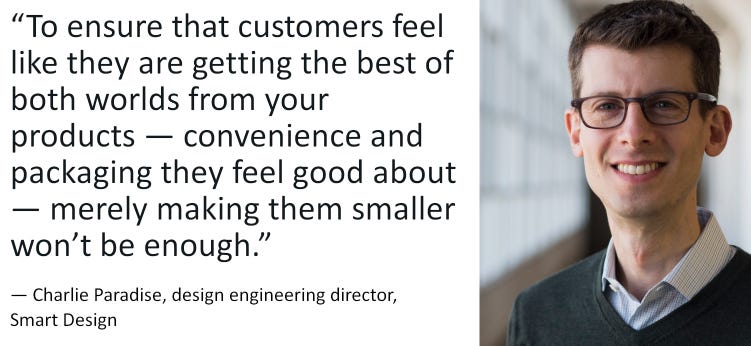Consumer perceptions of sustainability are impacted by more than what packaging material a product uses. How can your brand’s packaging truly live a “useful” life and gain their approval?

Another day, another depleted spray bottle reluctantly tossed into the recycling bin.
For the past few months — ever since our home has officially doubled as our office, gym, and kid’s classroom — we have become more intimately (and uncomfortably) in-tune with the amount of waste we produce. And we’re not alone: The rise in waste nationwide has been a problem for sanitation workers, while nearly half of consumers say that the COVID-19 pandemic has made them more concerned about the environment.
At Smart Design, we’ve worked with a lot of consumer packaged goods (CPG) partners over the years who, like their customers, would like to create less waste. Unfortunately, many current solutions don’t take the user experience into account. This is essential because without a positive user experience, consumers are less likely to adopt new behaviors and change what they purchase.
Take liquid refills, for example. Buying a large bottle that you can use to refill your hand soap several times saves plastic and keeps pump mechanisms out of the trash, as well as being more space efficient. However, these large bottles are often heavy and bulky, and refilling a soap bottle through a small neck is downright messy.
So what can we do about it? We’ve learned that concentrating the formula is a good start, but to really make your customers consider this a sustainable solution, you need to consider the complete user experience.
The subtle power of perception.
How does a consumer subconsciously determine whether a product’s packaging is appropriate or excessive? A solution’s perception — particularly for liquid CPG products like cleaning spray refills or single-serve drink pods — can vary based on the weight that individuals place on a number of values: cost, materials, convenience, the type of product, experience, market legacy, branding, and (most importantly) what they are familiar with. Analyzing and weaving together the results of all these variables can produce widely differentiated outcomes.
For established brands such as Gatorade and Cif, a concentrated pod strategy has allowed them to cut down significantly on their packaging, creating new, more sustainable offerings. With nowhere to go but up in the eyes of consumers, there is ample opportunity for well-known businesses such as these to leverage a deeper intent, refreshing their industry image through design. By focusing on redesigning familiar products, these companies have improved the perception of their offering and created a reason for customers to be loyal to their brand rather than straying off to seek sustainable alternatives.
For brands that are new to the market and are using sustainability as a differentiator, however, the lens through which consumers view the useful life of their products is different. With no prior stake in the ground — and no legacy or recognition to build upon — shoppers are more skeptical of the tradeoff between sustainable packaging and convenience, simply because it’s the only offering from that brand they’ve ever known.
When Smart Design was developing PepsiCo’s Drinkfinity — a system featuring pods that crack open to release a naturally flavored concentrate into a water-filled reusable bottle — we designed and tested two overarching architecture options, both of which used the same pod. In one version, the pod was cracked into the bottle, emptied and immediately discarded. In version two, the pod was cracked into the bottle, remained inside the bottle throughout consumption, and was discarded after the drink had been consumed.
We found that consumers — looking through the lens of a brand and product new to the market — perceived version one to be much more wasteful, as they were only “using the pod for a few seconds.” Version two was seen as being more sustainable. In both systems the pod was ultimately discarded — but having the pod as part of the system for a longer period of time had increased its perceived value to the user.

Designing a useful future.
Not only is sustainable refill packaging good for the environment, it’s good for business. Just last year, 37% of consumers surveyed for Toluna’s annual sustainability report said they were already actively seeking out environmentally friendly products and willing to pay up to 5% more for them. To ensure that customers feel like they are getting the best of both worlds from your products — convenience and packaging they feel good about — merely making them smaller won’t be enough. It takes an innovative approach toward sustainability, a best-in-class user experience mindset, and detailed psychological consumer research to create a solution that shoppers will truly love and embrace.
About the Author(s)
You May Also Like




